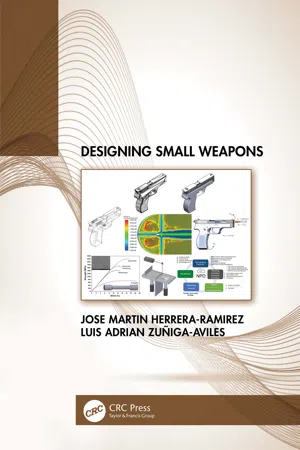
Designing Small Weapons
- 228 pages
- English
- ePUB (mobile friendly)
- Available on iOS & Android
Designing Small Weapons
About this book
This book focuses on developing small weapons, following the lifecycle of a firearm from design to manufacture. It demonstrates how modern technologies can be used at every stage of the process, such as design methodologies, CAD/CAE/CAM software, rapid prototyping, test benches, materials, heat and surface treatments, and manufacturing processes. Several case studies are presented to provide detailed considerations on developing specific topics.
Small weapons are designed to be carried by one person; examples are pistols, revolvers, rifles, carbines, shotguns, and submachine guns. Beginning with a review of the history of weapons from ancient to modern times, this book builds on this by mapping out recent innovations and state-of-the-art technologies that have advanced small weapon design. Presenting a comprehensive guide to computer design tools used by weapon engineers, this book demonstrates the capabilities of modern software at all stages of the process, looking at the computer-aided design, engineering, and manufacturing. It also details the materials used to create small weapons, notably steels, engineering polymers, composites, and emerging materials. Manufacturing processes, both conventional and unconventional, are discussed, for example, casting, powder metallurgy, additive manufacturing, and heat and surface treatments.
This book is essential reading to those in the field of weapons, such as designers, workers in research and development, engineering and design students, students at military colleges, sportsmen, hunters, and those interested in firearms.
Dr. Jose Martin Herrera-Ramirez is a military engineer with experience in the field of weapon and ammunition development. After receiving his PhD in Materials Science and Engineering from the Paris School of Mines in France, he was the head of the Applied Research Center and Technology Development for the Mexican Military Industry (CIADTIM). He now researches the development of metallic alloys and composites at the Research Center for Advanced Materials (CIMAV) in Chihuahua, Mexico.
Dr. Luis Adrian Zuñiga-Aviles is a military engineer with wide experience in the field of weapon and ammunition development. He was head of the prototypes and simulation departments at the Applied Research Center and Technology Development for the Mexican Military Industry (CIADTIM) and head of engineering of the Production directorate. He received his PhD in Science and Technology on Mechatronics from the Center for Engineering and Industrial Development (CIDESI) in Queretaro, Mexico. He now researches the new product design and development for military application, machinery, robotics, and medical devices in the Faculty of Medicine at the Autonomous University of Mexico State (UAEMex) and the Faculty of Engineering at UAEMex as part of the Researchers for Mexico program CONACYT.
Frequently asked questions
- Essential is ideal for learners and professionals who enjoy exploring a wide range of subjects. Access the Essential Library with 800,000+ trusted titles and best-sellers across business, personal growth, and the humanities. Includes unlimited reading time and Standard Read Aloud voice.
- Complete: Perfect for advanced learners and researchers needing full, unrestricted access. Unlock 1.4M+ books across hundreds of subjects, including academic and specialized titles. The Complete Plan also includes advanced features like Premium Read Aloud and Research Assistant.
Please note we cannot support devices running on iOS 13 and Android 7 or earlier. Learn more about using the app.
Information
1 History of the Design of Small Weapons
1.1 Introduction
1.1.1 The First Period
1.1.2 The Second Period
1.1.3 The Third Period
1.1.4 The Fourth Period
1.2 Evolution of Firearms

1.2.1 The Hand Cannon
1.2.2 The Matchlock System
1.2.3 The Wheellock System
Table of contents
- Cover
- Half Title Page
- Title Page
- Copyright Page
- Dedication Page
- Table of Contents
- List of Abbreviations
- Preface
- Acknowledgments
- Authors
- Chapter 1 History of the Design of Small Weapons
- Chapter 2 Beginning the Product Design
- Chapter 3 Custom and Functional Requirements
- Chapter 4 CAD Modeling and CAE Simulation
- Chapter 5 CAM Assessment and Rapid Prototyping
- Chapter 6 Experimental Physical Models, Test Benches, and Prototypes
- Chapter 7 Materials Used in the Production of Small Weapons
- Chapter 8 Heat Treatments and Surface Hardening of Small Weapon Components
- Chapter 9 Manufacturing Processes for Small Weapon Components
- Index